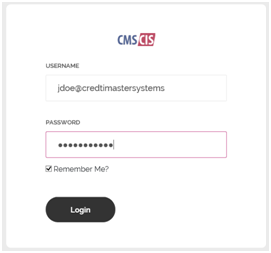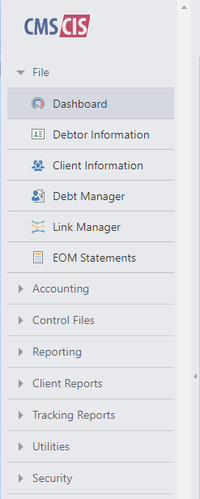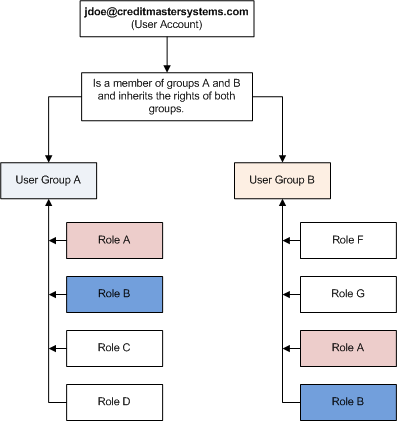CMSCIS
This online manual outlines the various processes involved in the management of the Credit Master Systems Complaint Information System (CMSCIS). The CMSCIS system was developed using MSSQL Server as the silo database with a browser based user interface using Microsoft ASP.NET MVC5.
Contents
- 1 System Security & Users Management
- 2 Debtor Information Management
- 2.1 New Debtor Creation
- 2.2 Searching Debtor Information Database
- 2.3 Addresses: Modify & Create Debtor Information
- 2.4 Employers: Modify & Create Debtor Information
- 2.5 Social Media Contacts: Modify & Create Debtor Information
- 2.6 Identification Sources: Modify & Create Debtor Information
- 2.7 Scanned Documents Management
- 2.8 Audit Trail: Search & View Activity
- 2.9 Debtor Details: Update Debtor Information
- 2.9.1 Comments: Create & Modify Debtor Comments Information
- 2.9.2 Tracking: Modify & Create Debtor Information
- 2.9.3 Deactivate & Activate Debtor Records
- 2.9.4 Debt History View
- 2.9.5 PCI (Personal Complaint Information) Issuance
- 2.9.6 Debtor CMS Online Search History
- 2.9.7 Debtor Information Quick Filters
System Security & Users Management
The management of users is an important aspect of any software system that can result in data leakage and mismanagement of system features by users. In an effort to provide a seamless user experience as well as control user access, a user group methodology was implemented in CMSCIS. A user will gain access to the features of the CMSCIS system by first using a set of assigned user credentials to login to the system from a network workstation.
The CMSCIS system is a browser based software system. This means that system users will utilize an internet browser on their workstations to navigate the system and utilize the system features to perform daily tasks. Internet browsers are of different types and may be Microsoft Internet Explorer, Mozilla Firefox or Google Chrome to name a few of the more widely used browsers. Microsoft Edge Browser or Google Chrome browser have been designated as the default Internet Browsers and have been verified to work with all system features. The URL to access the CMSCIS system on the local network is as follows:
Using the above URL address in Microsoft Edge Browser will direct the user to the login window as illustrated below.
The username and password provided to the user should be used to authenticate access to the CMSCIS system. The default landing page upon successful authenticate of credentials will be the “Dashboard”. The image below illustrates the Dashboard of a user belonging to the “Administrator” user group. Users of different groups will be presented with a different cluster of controls on their dashboard as shown below:
The main system menu used to navigate the CMSCIS system is located to the left of the browser window. The below image illustrates that the current system interface is the “DASHBOARD”. Left clicking on any of the menu navigation links will take you to the corresponding system module. This menu is collapsible using the collapse arrow located on the right of the system menu. The system menu is also scroll activated and allows for scrolling using a mouse scroll wheel.
Security Methodology
The CMSCIS system utilizes a “User Group – User” method of managing user access to system features. This method of user management is referred to as “Role Based Security” in ASP.NET MVC5. A user group is created in the CMSCIS system and system user accounts are then assigned to a created user group. Each user group is then assigned roles to perform a set of tasks specific to all users in the group.
Definitions:
- User – A user can be defined as a person who uses or operates something, especially a computer or other machine. “Users” of the CMSCIS system are those individuals who have been granted access to the system using a specified set of credentials known by them alone. These credentials include a username and a password. User names are assigned using the “creditmastersystems.com” domain name in the following format jdoe@creditmastersystems.com. This format includes the first initial and last name with the domain name appended.
- Role – A role is a system module that allows an authenticated user to perform a specific task in the CMSCIS system. An example of such a role, as it pertains to the CMSCIS system, is called “ADJOURNMENTS”. This role allows a user to “UPDATE COURT DATE (ADJOURNMENT)”. Roles in the CMSCIS system can be of two types either a “COMMAND” or a “MENU”. These designations refer to the role being a command button that executes a specific task or a menu option that gives access to a system window or interface respectively.
- User Group – A user group can be defined as a group of people with the same interests, who use a particular product or service. With this definition in mind a group of system users who all perform the same tasks in the CMSCIS system are therefore referred to as a “user group”. A user group is created in the CMSCIS and system “roles “ or “rights” are granted to the user group.
The diagram below is a visual representation of the implementation of roles, users and groups in the CMSCIS system. The diagram illustrates the existence of two user groups “User Group A” and “User Group B”. Both these user groups have been assigned system roles respectively. The diagram indicates that the user “jdoe@creditmastersystems” has been created in the CMSCIS system and has been assigned both defined system groups, “User Group A” and “User Group B”.
This diagram illustrates an important feature to be taken into consideration in the administration of system users. A user can be assigned to one or more groups at a time. This is a feature of the CMSCIS system. As illustrated above both user groups have “Role A” and “Role B” but are different in the existence of “Role C” and “Role D” in User Group A and “Role F” and “Role G” in User Group B. When assigned to both user groups, system user jdoe@creditmastersystems will have access to all features of both groups. This feature allows for flexibility in the assignment of groups to a user and allows for the potential for elevated or reduced accessibility at the discretion of the system administrator.
System Role Creation
Note: The steps outlined in this section are for information purposes on the usage of this system feature. All new system roles do not automatically become activated but will require implementation into the software code to become usable.
- Navigate the main menu option to select the "Security" sub menu. On the sub menu please select the “Security Roles” option and left click.
- The figure below is a representation of the main roles user interface. This page is used to create and update systems roles that allow users to perform work tasks in the CMSCIS system. The “Grid Filter Options” allows for quick filtering of the main grid to allow for fast location of systems roles based on the selected filter type. Each column on the grid can also be filtered by typing words in the columns. The grid will automatically begin to perform a search based on the provided word criteria and present results in the filtered grid. To clear all filters and reset the grid to its initial state the “ALL” filter in the left filter menu should be clicked.




